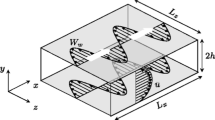Abstract
A formulation of the skin-friction drag related to the Reynolds shear stress in a turbulent channel flow is derived. A direct numerical simulation (DNS) of the turbulent control is performed by imposing the spatially oscillating spanwise Lorentz force. Under the action of the Lorentz force with several proper control parameters, only the periodically well-organized streamwise vortices are finally observed in the near-wall region. The Reynolds shear stress decreases dramatically, especially in the near-wall area, resulting in a drag reduction.
Similar content being viewed by others
References
Theodorsen, T. Mechanism of turbulence. Proceedings of the 2nd Midwestern Conference on Fluid Mechanics, Ohio State University, Ohio, 1–18 (1952)
Kline, S. J., Reynolds, W. C., Schraub, F. A., and Runstadler, P. W. The structure of turbulent boundary layers. Journal of Fluid Mechanics, 30, 741–773 (1967)
Cantwell, B. J. Organized motion in turbulent flow. Annual Review of Fluid Mechanics, 13, 457–515 (1981)
Kim, J., Moin, P., and Moser, R. D. Turbulence statistics in fully developed channel flow at low Reynolds number. Journal of Fluid Mechanics, 177, 133–166 (1987)
Blackwelder, R. F. and Kaplan, R. E. On the wall structure of the turbulent boundary layer. Journal of Fluid Mechanics, 76, 89–112 (1976)
Lee, C. B. and Wu, J. Z. Transition in wall-bounded flows. Applied Mechanics Reviews, 61, 030802 (2008)
Lee, C. B. and Lee, R. Q. Dominant structure for turbulent production in a transitional boundary layer. Journal of Turbulence, 8, 1–34 (2007)
Kim, J. and Bewley, T. R. A linear systems approach to flow control. Annual Review of Fluid Mechanics, 39, 383–417 (2007)
Kim, J. Physics and control of wall turbulence for drag reduction. Philosophical Transactions of the Royal Society, A: Mathematical, Physical and Engineering Sciences, 369, 1396–1411 (2011)
Choi, K. Near-wall structure of turbulent boundary layer with spanwise-wall oscillation. Physics of Fluids, 14, 2530–2542 (2002)
Ricco, P. and Wu, S. On the effects of later wall oscillation on a turbulent boundary layer. Experimental Thermal and Fluid Science, 29, 41–52 (2004)
Quadrio, M., Ricco, P., and Viotti, C. Streamwise-travelling waves of spanwise wall velocity for turbulent drag reduction. Journal of Fluid Mechanics, 627, 161–178 (2009)
Kang, S. and Choi, H. Active wall motions for skin-friction drag reduction. Physics of Fluids, 12, 3301–3304 (2000)
Endo, T., Kasagi, N., and Suzukin, Y. Feedback control of wall turbulence with wall deformation. International Journal of Heat and Fluid Flow, 21, 568–575 (2000)
Shen, L., Zhang, X., Yue, K. P., and Triantafyllou, M. S. Turbulent flow over a flexible wall undergoing a streamwise traveling wave motion. Journal of Fluid Mechanics, 484, 197–221 (2003)
Min, T., Kang, S. M., Speyer, J. L., and Kim, J. Sustained sub-laminar drag in a fully developed channel flow. Journal of Fluid Mechanics, 558, 309–318 (2006)
Lee, C., Min, T., and Kim, J. Stability of channel flow subject to wall blowing and suction in the form of a traveling wave. Physics of Fluids, 20, 10153 (2008)
Zhang, H., Fan, B. C., Chen, Z. H., and Li, Y. L. Underlay mechanism in lift-drag phase diagrams for shear flow over cylinder. Applied Mathematics and Mechanics (English Edition), 35(2), 221–228 (2014) DOI 10.1007/s10483-014-1785-8
Zhu, Z. J., Niu, J. L., and Li, Y. L. Swirling-strength based large eddy simulation of turbulent flow around single square cylinder at low Reynolds numbers. Applied Mathematics and Mechanics (English Edition), 35(8), 959–978 (2014) DOI 10.1007/s10483-014-1847-7
Huang, L. P., Fan, B. C., and Dong, G. Turbulent drag reduction via a transverse wave travelling along streamwise direction induced by Lorentz force. Physics of Fluids, 22, 015103 (2010)
Wu, W. T., Hong, Y. J., and Fan, B. C. Vortex structures in turbulent channel flow modulated by spanwise Lorentz force with steady distributions. Acta Physica Sinica, 63, 054702 (2014)
Author information
Authors and Affiliations
Corresponding author
Additional information
Supported by the National Natural Science Foundation of China (Nos. 11172140 and 11372356) and the Open Project of State Key Laboratory of Explosion Science and Technology in Beijing Institute of Technology (No.KFJJ13-3M)
Rights and permissions
About this article
Cite this article
Wu, W., Hong, Y. & Fan, B. Numerical investigation of turbulent channel flow controlled by spatially oscillating spanwise Lorentz force. Appl. Math. Mech.-Engl. Ed. 36, 1113–1120 (2015). https://doi.org/10.1007/s10483-015-1972-6
Received:
Revised:
Published:
Issue Date:
DOI: https://doi.org/10.1007/s10483-015-1972-6




